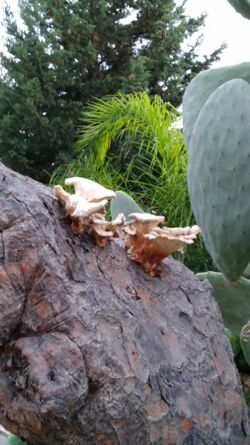Biology:Pleurotus opuntiae
| Pleurotus opuntiae | |
|---|---|

| |
| P. opuntiae mushrooms growing on dead remains of Opuntia | |
| Scientific classification | |
| Domain: | Eukaryota |
| Kingdom: | Fungi |
| Division: | Basidiomycota |
| Class: | Agaricomycetes |
| Order: | Agaricales |
| Family: | Pleurotaceae |
| Genus: | Pleurotus |
| Species: | P. opuntiae
|
| Binomial name | |
| Pleurotus opuntiae (Durieu y Lév.) Sacc. (1887)
| |
| Synonyms | |
| |
| Pleurotus cornucopiae | |
|---|---|
| Mycological characteristics | |
| gills on hymenium | |
| cap is offset | |
| hymenium is decurrent | |
| stipe has a ring | |
| spore print is white | |
| ecology is saprotrophic or parasitic | |
| edibility: edible | |
Pleurotus opuntiae is a species of Agaricales fungus that grows in the semi-arid climate of central Mexico[1] and in New Zealand,[2] whose mushroom is edible and considered a delicacy in the cuisine of indigenous peoples of Mexico. It is known as hongo de maguey común in Mexican Spanish, seta de chumbera/nopal in Peninsular Spanish, and kjoo'wada in Otomi language.[3] Phylogenetic research has shown that while it belongs to P. djamor-cornucopiae clade, it forms its own intersterility group,[4] but it has also been claimed to be genetically inter-incompatible with P. australis, P. ostreatus (extra-limital), P. pulmonarius and P. purpureo-olivaceus of New Zealand.[2]
Description
P. opuntiae fruits gregariously in groups of several specimens on dead remains of the plant Opuntia megacantha (es), from which the binomial name of the fungus derives. They are beige or cream in color. Its gills are very decurrent and its cap, from 1 to 6 centimetres (1⁄2 to 2 1⁄4 in) in diameter, is quite flat and funnel-shaped, slightly rolled at the edges. It has either a very short stipe, or often basically nonexistent one.[5]
References
- ↑ Camacho, Marcelo; Guzman, Gaston; Guzman-Davalos, Laura (January 2012). "Pleurotus opuntiae (Durieu et Lev.) Sacc. (Higher Basidiomycetes) and Other Species Related to Agave and Opuntia Plants in Mexico−Taxonomy, Distribution, and Applications" (in en). International Journal of Medicinal Mushrooms 14 (1): 65–78. doi:10.1615/IntJMedMushr.v14.i1.70. PMID 22339709. https://www.researchgate.net/publication/221837336. Retrieved 6 June 2020.
- ↑ 2.0 2.1 Segedin, BP; Buchanan, PK; Wilkie, JP (1995). "Studies in the agaricales of New Zealand: New species, new records and renamed species of Pleurotus (Pleurotaceae)". Australian Systematic Botany 8 (3): 453–482. doi:10.1071/SB9950453.
- ↑ Taller de Etnomicología, Facultad de Ciencias, National Autonomous University of Mexico (UNAM), “Importancia cultural de los hongos en México”, Arqueología Mexicana, edición especial, núm. 87, pp. 30-33.
- ↑ Vilgalys, R.; Moncalvo, J.M.; Liou, S.R.; Volovsek, M. (1996). "Recent advances in molecular systematics of the genus Pleurotus". in Royse, D.J.. Mushroom biology and mushroom products: proceedings of the 2nd International Conference, June 9–12, 1996. University Park, PA (USA): Pennsylvania State University: World Society for Mushroom Biology and Mushroom Products. pp. 91–101. http://wsmbmp.org/proceedings/2nd%20international%20conference/MBMP%20Proceedings%20of%20the%202nd%20International%20Conference%20(White%20book)/8%20Recent%20Advances%20in%20Molecular%20Systematics%20of%20the%20Genus%20Pleurotus.pdf. Retrieved 2011-03-10.
- ↑ "Pleurotus opuntiae" (in es). Asociación Micológica Pie Azul de Monesterio. 2014. https://pieazul.es/pleurotus-opuntiae/.
Wikidata ☰ Q12239196 entry
 |

